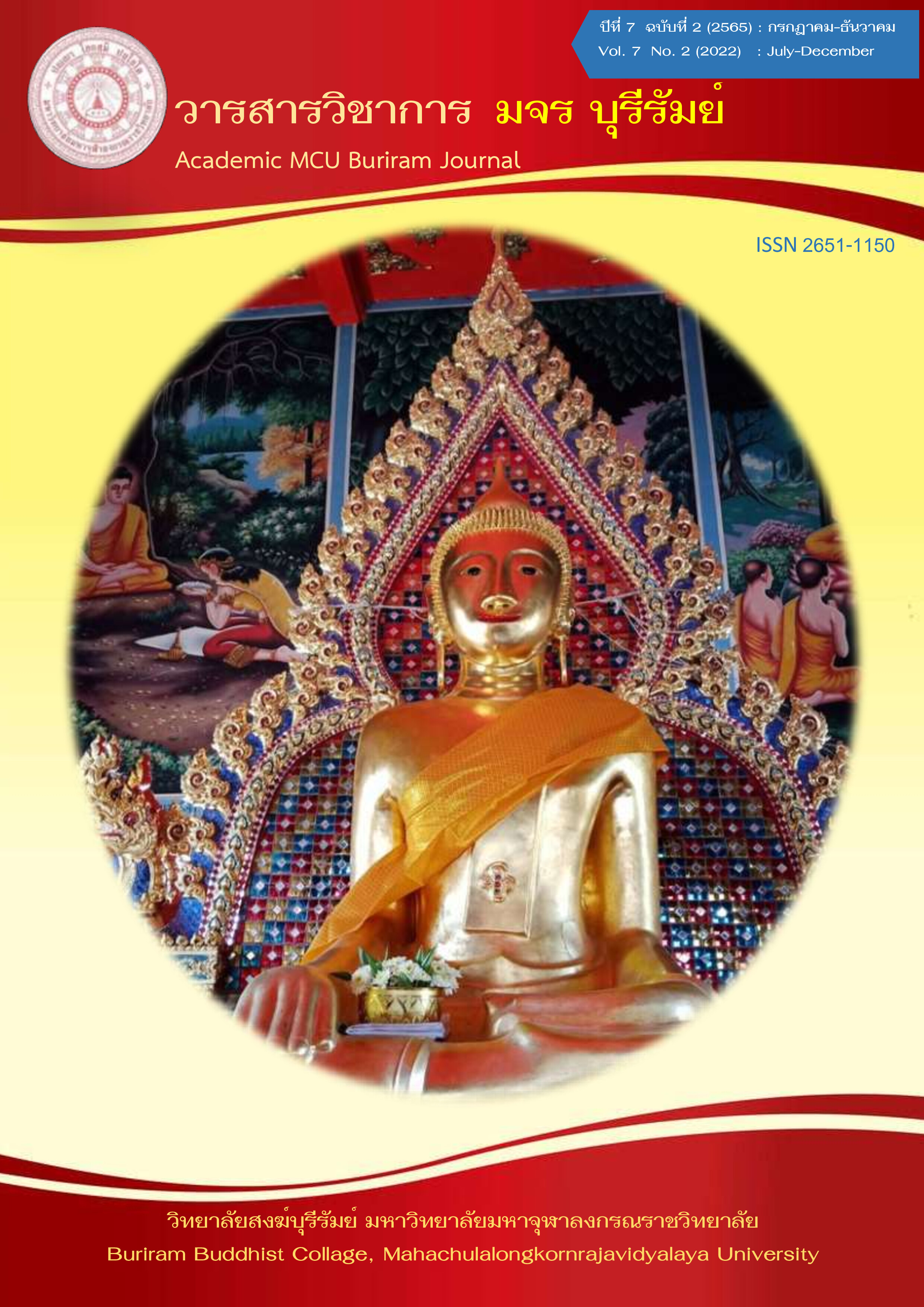The Study of Computational Thinking and Science and Technology (Computing Science) Learning Achievement on Using Logical Thinking to Solve the Problems of Students in Grade 6 By Using Engineering Design Process: A Multivariate Analysis of Covariance
Keywords:
Computational Thinking, Kuruthaniyadhamma, Philosophy of Sufficiency EconomyAbstract
The purpose of this research is to compare the computational thinking and computing science learning achievement on using logical thinking to solve the problems of students in grade 6 between before and after learning by using engineering design process when controlling scientific problem-solving ability. The sample in this study consisted of 22 students in Grade 6 at Wat Amphawan School during the second semester of the 2021 academic year. The research instruments include the following; 1) lesson plans based on engineering design process, 2) computational thinking test (p = 0.600 – 0.773,
r = 0.570 – 0.884, and Reliability = 0.960), 3) computing science learning achievement tests (p = 0.440 – 0.720, r = 0.209 – 0.714, and Reliability = 0.840), 4) scientific problem-solving ability test (p = 0.587 – 0.747, r = 0.551 – 0.947 and Reliability = 0.967). The statistics used in this study were 1) descriptive statistics, which used mean, standard deviation, skewness, kurtosis and 2) hypothesis test with Multivariate Analysis of Covariance (MANCOVA).
The results of the research showed that:
The mean scores of computational thinking and computing science learning achievement when controlling scientific problem-solving ability of posttest were higher than those of pretest at the statistically significant .05 level (F = 15.213, df = 2, p = .000), the mean scores of pretest of computational thinking and computing science learning achievement were 15.955 (S.D. = 0.594) and 7.182 (S.D. = 0.472) while the mean scores of posttest of computational thinking and computing science learning achievement were 34.000 (S.D. = 0.499) and 15.864 (S.D. = 0.316) respectively.
References
ณัฐวุฒิ อรุณรัตน์. (2561). ผลการใช้กลุ่มสืบสอบร่วมกับเครื่องมือการเรียนรู้ร่วมกันออนไลน์ด้วยกระบวนการออกแบบวิศวกรรมที่มีต่อความสามารถในการแก้ปัญหาอย่างสร้างสรรค์ของนักเรียนมัธยมศึกษาตอนปลาย. ปริญญานิพนธ์มหาบัณฑิต. จุฬาลงกรณ์มหาวิทยาลัย: กรุงเทพฯ.
ทิศนา แขมมณี. (2553). ศาสตร์การสอน องค์ความรู้เพื่อการจัดกระบวนการเรียนรู้ที่มีประสิทธิภาพ. กรุงเทพฯ: จุฬาลงกรณ์มหาวิทยาลัย.
น้ำฝน เบ้าทองคำ และ กฤษณา ปิ่นป้อง (2561). ผลสัมฤทธิ์ทางการเรียนวิทยาศาสตร์ เรื่อง สารละลายกรดและเบส โดยใช้การจัดการเรียนรู้แบบบูรณาการเป็นฐานสำหรับนักเรียนชั้นมัธยมศึกษาปีที่ 1. วารสารครุพิบูล, 6(2), 219-230.
พิเชฐ ศรีสังข์งาม และ ชัยยศ เดชสุระ. (2564). การพัฒนากิจกรรมการเรียนรู้ตามแนวทางสะเต็มศึกษาเพื่อส่งเสริมทักษะการคิดเชิงคำนวณของผู้เรียนระดับชั้นมัธยมศึกษาตอนต้น. วารสารวิจัยราชภัฏกรุงเก่า, 18(2), 107-114.
สถาบันส่งเสริมการสอนวิทยาศาสตร์และเทคโนโลยี. (2560). คู่มือการใช้หลักสูตรรายวิชาพื้นฐานวิทยาศาสตร์ สาระเทคโนโลยี (วิทยาการคำนวณ) ระดับประถมศึกษา และมัธยมศึกษา. https://www.scimath.org/ebook-technology/item/ 8376-2560-2551 (สืบค้นเมื่อ 13 สิงหาคม 2564)
อาทิตย์ ฉิมกุล. (2559). ผลของการจัดการเรียนรู้ชีววิทยาตามแนวคิดสะเต็มศึกษาที่มีต่อความสามารถในการแก้ปัญหาและผลสัมฤทธิ์ทางการเรียนชีววิทยาของนักเรียนระดับมัธยมศึกษาตอนปลาย. Online Journal of Education, 12(1), 324-342.
อิทธิพัทธ์ สุวทันพรกูล. การวิจัยทางการศึกษา : แนวคิดและการประยุกต์ใช้. พิมพ์ครั้งที่ 2. กรุงเทพฯ: ภาควิชาการวัดผลและวิจัยการศึกษา คณะศึกษาศาสตร์ มหาวิทยาลัยศรีนครินทรวิโรฒ.
Capobianco, B. M., Nyquist, C., & Tyrie, N. (2013). Shedding Light on Engineering Design. Science and Children, 50(5), 58.
Leonard, J., Buss, A., Gamboa, R., Mitchell, M., Fashola, O. S., Hubert, T., & Almughyirah, S. (2016). Using robotics and game design to enhance children’s self-efficacy, STEM attitudes, and computational thinking skills. Journal of Science Education and Technology, 25(6), 860-876.
Román-González, M., Pérez-González, J.-C., & Jiménez-Fernández, C. (2017). Which cognitive abilities underlie computational thinking? Criterion validity of the Computational Thinking Test. Computers in Human Behavior, 72, 678-691.
Shahali, E. H. M., Halim, L., Rasul, M. S., Osman, K., & Zulkifeli, M. A. (2016). STEM learning through engineering design: Impact on middle secondary students’ interest towards STEM. EURASIA Journal of Mathematics, Science and Technology Education, 13(5), 1189-1211.
Wing, J. M. (2006). Computational thinking. Communications of the ACM, 49(3), 33-35.
Downloads
Published
How to Cite
Issue
Section
License
Copyright (c) 2022 Academic MCU Buriram Journal

This work is licensed under a Creative Commons Attribution-NonCommercial-NoDerivatives 4.0 International License.
ทัศนะและความคิดเห็นที่ปรากฏในบทความวารสารฉบับนี้ถือเป็นความรับผิดชอบของผู้เขียนบทความนั้น ไม่ถือเป็นทัศนะและความรับผิดชอบของบรรณาธิการ





